Photo showing rounded facet junctions on stone on left, and color banding in stone on right.
I was wearing a head loupe and also used a 10 power hand held jewelers loupe. ( I just did a test; wearing my reading glasses and using the little super magnifying circle in a common magnifying glass, I was able to see almost as well.) I began with the largest stones. The first thing that I noticed was that the facets on the bottom part of the stone, the pavillion, had a smeared appearance, or very slight parallel scratches. A properly cut and polished gemstone has perfectly smooth facets.
Photo showing depression where cast material has contracted upon cooling. Also streaky lines on facet planes.
Having been clued in that some of the stones were probably glass, I was looking for two characteristics which are strong indicators for glass. The first, tiny gas bubbles inside the stone. The second is conchoidal breakage. Conchoidal breakage is where damage to the stone has the appearance of a shell, a scallop shape with concentric ridges. This damage often occurs where the stone has been set, such as under a prong. Conchoidal breakage is very typical on glass but can also be found on quartz. For the stones I was looking at, the occurrence of conchoidal breakage was not going to help me definitively distinguish between citrine and glass, but it is easy to spot, and interesting. I found both conchoidal breakage and gas bubbles in a couple of the stones.
By this time I was pretty sure that the large square stones were glass. But I was into it now. I noticed that the facet junctions, the ridge where two facets meet, were not super crisp, but very slightly rounded. An indication of glass that has been cast in a mold. The facet junctions on cut gemstones are very crisp.
Suddenly I saw something which I should have seen immediately, because I could see it with my naked eyes, and that was that the material had contracted upon cooling! Each of the 3 large stones had this, and on one, the one in the photograph, it is very apparent. So definitely the 3 largest stones were cast in molds, they could even be hard plastic, which might account for the streaks along the facets. The more I looked, the more I noticed. The last thing that I saw was that in the smaller rectangular stones, there is color banding, something found in gemstones, but not glass. Finally, and this is subtle, the 5 smaller stones felt cooler than the 5 larger ones.
Photo showing the impostors on the left and the genuine citrines on the right.
My conclusion, the 5 largest stones are glass, or maybe plastic, and the 5 smaller stones are citrine. A fun and interesting way to spend 45 minutes. I came in and told my husband what I had been doing, and he said “blog post”, so here it is! Happy Scottish gem sleuthing!










Thank you so much for taking the time to share your process and results. I really appreciate your detailed explanations and the definitions provided in terms I could understand perfectly. Last, the photos! Great, great photos. I’ll be keeping an eye on you and what other things you know and share.
Anita ^..^
really fine article. I would have been helpful if you could have shown the magnified version of the good and the bad (glass). I have a jewler’s loop. It has conical breakage, but I can’t find a bubble. There is only one color band. I’m stymied. Thanks !
OMGosh there is NO WAY to correct typos … what sort of site … ?
thanks for the advice given in this blog – it was very helpful to me (as a potential buyer) of an allegedly old plaid brooch and citrine stone. – it was glass
Thank you!
It is very informative.Thank you
Can you get rounded facet junctions from over polishing a stone so the appear slightly rounded and not “super crisp”?
Hi Cheri, it all depends on the hardness of the stone and the abrasiveness of the polish. Citrine, which is quartz, is quite hard, Mohs 7, and will not be abraded by most jewelry polishing compounds.